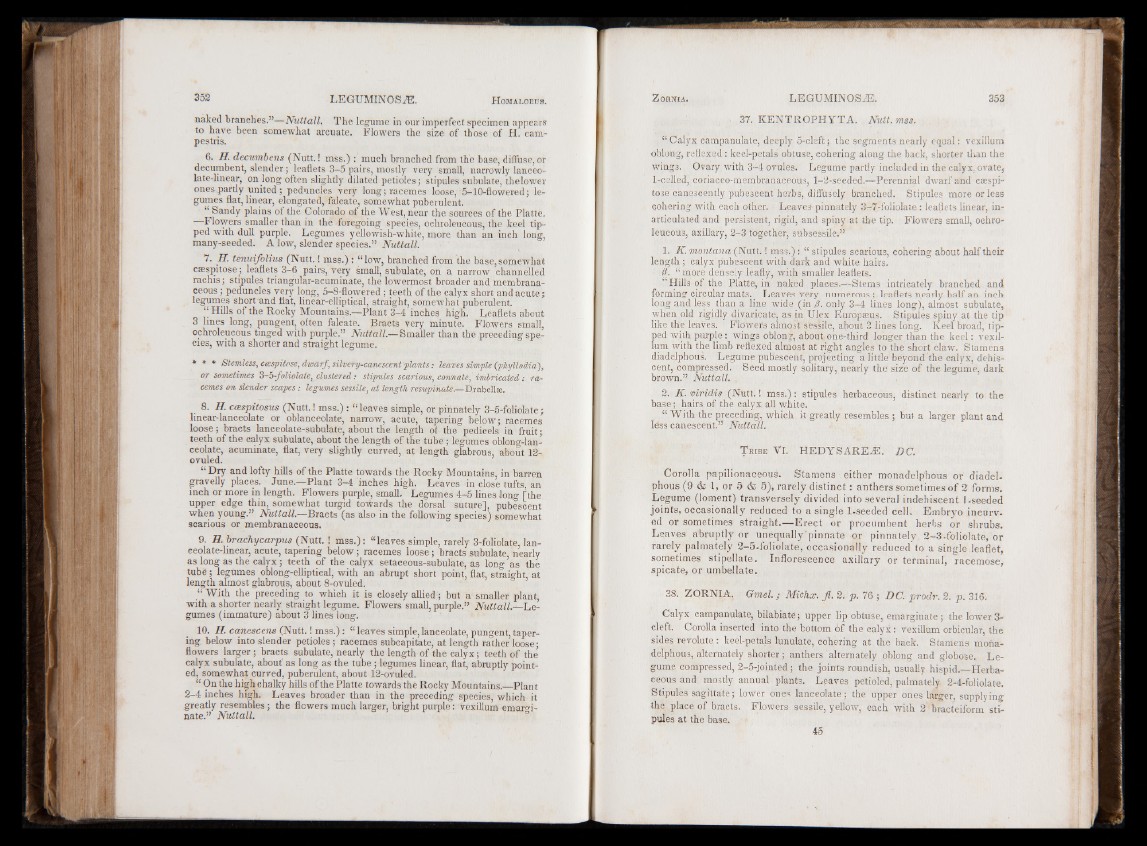
naked branches.”—Nuttall. The legume in our imperfect specimen appears
to have been somewhat arcuate. Flowers the size of those of H. cam-
pestris.
6. H. decumbens (Nutt.! mss.) ( much branched from the base, diffuse, or
decumbent, slender; leaflets 3—5 pairs, mostly very small, narrowly lanceolate
linear, on long often slightly dilated petioles; stipules subulate, the lower
ones^partly united; peduncles very long; racemes loose, 5- 10-flowered; legumes
flat, linear, elongated, falcate, somewhat puberulent.
“ Sandy plains of the Colorado of the West, near the sources of the Platte.
—Flowers smaller than in the foregoing species, ochroleucous, the keel tipped
with dull purple. Legumes yellowish-while, more than an inch long,
many-seeded. A low, slender species.” Nuttall.
7. H. tenuifolius (Nutt.! mss.) : “ low, branched from the base,somewhat
csespitose; leaflets 3-6 pairs, very small, subulate, on a narrow channelled
rachis; stipules triangular-acuminate, the lowermost broader and membranaceous
; peduncles very long, 5-8-flowered; teeth of the calyx short and acute j
legumes short and flat, linear-elliptipal, straight, somewhat puberulent.
“ Hills of the Rocky Mountains.—Plant 3-4 inches high. Leaflets about
3 lines long, pungent, olten falcate. Bracts very minute. Flowers small,
ochroleucous tinged with purple.” Nuttall.—Smaller than the preceding species,
with a shorter and straight legume.
* * * Stemless, ctzspitose, dwarf, silvery-canescent 'plants: leaves simple (phyllodia),
or sometimes 3-5-foliolate, clustered: stipules scarious, connate, imbricated: racemes
on slender scapes : legumes sessile, at length reswpinate.—Drabell*.
8. H. caspitosus (Nutt.! mss.) : “ leaves simple, or pinnately 3-5-foliolate;
linear-lanceolate or oblanceolate, narrow, acute, tapering below; racemes
loose; bracts lanceolate-subulate, about the length of the pedicels in fruit -
teeth of the calyx subulate, about the length of the tube ; legumes oblong-lanceolate,
acuminate, flat, very slightly curved, at length glabrous, about 12-
ovuled.
“ Dry and lofty hills of the Platte towards the Rocky Mountains, in barren
gravelly places. June.—Plant 3-4 inches high. Leaves in close tufts, an
inch or more in length. Flowers purple, small. Legumes 4 -5 lines long [the
upper edge thin, somewhat turgid towards the dorsal suture], pubescent
when young.” Nuttall.—Bracts (as also in the following species) somewhat
scarious or membranaceous.
9. H. br achy carpus (Nutt. ! mss.): “ leaves simple, rarely 3-foliolate, lanceolate
linear, acute, tapering below; racemes loose; bracts subulate, nearly
as long as the calyx; teeth of the calyx setaceous-subulate, as long’as the
tube; legumes oblong-elliptical, with an abrupt short point, flat, straight at
length almost glabrous, about 8-ovuled.
“ With the preceding to which it is closely allied; but a smaller plant,
with a shorter nearly straight legume. Flowers small, purple.” Nuttall.—Legumes
(immature) about 3 lines long.
10. H. canescens (Nutt.!!mss.): “ leaves simple,lanceolate, pungent,tapering
below into slender petioles ; racemes subcapitate, at length rather loose;
flowers larger ; bracts subulate, nearly the length of the calyx; teeth of the’
calyx subulate, about' as long as the tube ; legumes linear, flat, abruptly pointed,
somewhat curved, puberulent, about 12-ovuled.
“ On the high chalky hills of the Platte towards the Rocky Mountains.—Plant
2-4 inches high. Leaves broader than in the preceding species, which it
greatly resembles; the flowers much larger, bright purple: vexillum emar°-i-
nate.” Nuttall.
■ 37. KENTROPHYTA. Nutt. mss.
“ Calyx campanulate, deeply 5-cleft; the segments nearly equal: vexillum
oblong, reflexed : keel-petals obtuse, cohering along the back, shorter than the
wings'. Ovary with 3-4 ovules. Legume partly included in the calyx, ovate,
1-celled, coriaceo-membranaceous, 1-2-seeded.—Perennial dwarf and cæspi-
tose canescently pubescent herbs, diffusely branched. Stipules more or less
qohering with each other. Leaves-pinnately 3-7-foliolate : leaflets linear, in-
articulated and persistent, rigid, and spiny at the tip. Flowers small, ochroleucous,
axillary, 2-3 together, subsessile.”
1. K. montana (Nutt. ! mss. ) : “ stipules scarious, cohering about half their
length ; calyx pubescent with dark and white hairs.
II. “ more densely leafly, with smaller leaflets.
‘Hills of the Platte, in naked places.—Stems intricately branched and
forming circular mats. Leaves very numerous ;, leaflets nearly half an inch
long and less than a line wide (in 0. only 3-4 lines long), almost subulate,
when old rigidly divaricate, as in Ulex Europæus. Stipules spiny at the tip
like the leaves. Flowers almost sessile, about 3 lines long. Keel broad, tipped
with purple : wings oblong, about one-third longer than the keel : vexillum
with the limb refleXed almost at right angles to the short claw. Stamens
diadelphous. Legume pubescent, projecting a little beyond the calyx, dehiscent,
compressed. Seed mostly solitary, nearly the size of the legume, dark
brown.” Nuttall. ,
2. K. viridis (Nutt. ! mss.) : stipules herbaceous, distinct nearly to the
base ; hairs of the calyx all white.
“ With the preceding, which it greatly resembles ; but a larger plant and
Idss canescent.” Nuttall.
T r ib e VI. HEDYSAREÆ. DC.
Corolla papilionaceous. Stamens either monadelphous or diadel-
phous (9 & 1, or 5 & 5), rarely distinct : anthers sometimes o f 2 forms.
Legume (loment) transversely divided into several indéhiscent I.seeded
joints, occasionally reduced to a single 1-seeded cell. Embryo incurv-
ed or sometimes straight.— Erect or procumbent herbs or shrubs.
Leaves abruptly or Unequally’pinnate or pinnately, 2-3-foIiolate, or
rarely palmately 2-5-foliola'te, occasionally reduced to a single leaflet,
sometimes stipellate. Inflorescence axillary or terminal, racemose,
spicate, or umbellate.
38. ZORNIA. G Mel. • Michx. fl. 2. p. 76 ; DC. prodr. 2. p. 316.
Calyx campanulate, bilabiate; upper lip obtuse, emarginate ; the lower 3-
cleft. Corolla inserted into the bottom of the calyx : vexillum orbicular, the
sides revolute : keel-petals lunulate, cohering at the back. Stamens monadelphous,
alternately shorter ; anthers alternately pblong and globose. Legume
compressed, 2-5-jointed ; the joints roundish, usually hispid.—Herbaceous
and mostly annual plants. Lpaves petioled, palmately 2-4-foliolate.
Stipules sagittate; lower ones lanceolate; the upper ones larger, supplyin<s-
the place of bracts. Flowers sessile, yellow, each with 2 bracteiform stipules
at the base.